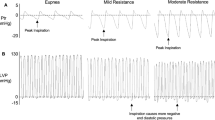Abstract
The frontal QRS-T angle on the electrocardiogram has been described as a variable of ventricular repolarization. We evaluated how deep inspiration affected QRS axis, T-wave axis and frontal QRS-T angle. We also assessed the effects on left ventricular volume on the association using myocardial perfusion SPECT. Fifty patients undergoing ECGs both in resting state and in deep inspiration and subsequent SPECT were enrolled. Frontal QRS-T angle was defined as the absolute value of the difference between the frontal QRS axis and T-wave axis. Change in frontal QRS-T angle was calculated using (QRS-T angle in deep inspiration−QRS-T angle in resting state). In resting state, QRS axis and T-wave axis were 20.9° ± 30.0° and 40.9° ± 36.1°, respectively. Frontal QRS-T angle was 35.9° ± 36.1°. Deep inspiration caused rightward shifts of QRS axis (42.3° ± 29.5°, p < 0.001) and T-wave axis (49.5° ± 39.7°, p < 0.001). However, deep inspiration did not affect frontal QRS-T angle (33.9° ± 35.8°, p = 0.44). Frontal QRS-T angle in deep inspiration had good correlation (r = 0.87, p < 0.001) and agreement with that in resting state. Left ventricular (LV) end-diastolic volume had a significant association with change in frontal QRS-T angle (r = 0.29, p = 0.04). Our data suggest that frontal QRS-T angle in deep inspiration has a good correlation with that in resting state, and the agreement is acceptable. In patients with dilated LV, QRS-T angle in deep inspiration may be susceptible to the overestimation.


Similar content being viewed by others
References
Aro AL, Huikuri HV, Tikkanen JT, Junttila MJ, Rissanen HA, Reunanen A, Anttonen O (2012) QRS-T angle as a predictor of sudden cardiac death in a middle-aged general population. Europace 14:872–876
Gotsman I, Keren A, Hellman Y, Banker J, Lotan C, Zwas DR (2013) Usefulness of electrocardiographic frontal QRS-T angle to predict increased morbidity and mortality in patients with chronic heart failure. Am J Cardiol 111:1452–1459
May O, Graversen CB, Johansen MØ, Arildsen H (2017) A large frontal QRS-T angle is a strong predictor of the long-term risk of myocardial infarction and all-cause mortality in the diabetic population. J Diabetes Complicat 31:551–555
Chen S, Hoss S, Zeniou V, Shauer A, Admon D, Zwas DR, Lotan C, Keren A, Gotsman I (2018) Electrocardiographic predictors of morbidity and mortality in patients with acute myocarditis: the importance of QRS-T angle. J Card Fail 24:3–8
May O, Graversen CB, Johansen MØ, Arildsen H (2018) The prognostic value of the frontal QRS-T angle is comparable to cardiovascular autonomic neuropathy regarding long-term mortality in people with diabetes. A population based study. Diabetes Res Clin Pract 142:264–268
Lazzeroni D, Bini M, Camaiora U, Castiglioni P, Moderato L, Ugolotti PT, Brambilla L, Brambilla V, Coruzzi P (2018) Prognostic value of frontal QRS-T angle in patients undergoing myocardial revascularization or cardiac valve surgery. J Electrocardiol 51:967–972
Borleffs CJ, Scherptong RW, Man SC, van Welsenes GH, Bax JJ, van Erven L, Swenne CA, Schalij MJ (2009) Predicting ventricular arrhythmias in patients with ischemic heart disease: clinical application of the ECG-derived QRS-T angle. Circ Arrhythm Electrophysiol 2:548–554
Smit D, de Cock CC, Thijs A, Smulders YM (2009) Effects of breath-holding position on the QRS amplitudes in the routine electrocardiogram. J Electrocardiol 42:400–404
Uematsu Y, Moriwaki M, Yoshikawa M, Takahashi N, Kiraku J, Ashida T (1997) QRS axis shift in deep breathing. Rinsho Byori 45:595–598
Kurisu S, Nitta K, Sumimoto Y, Ikenaga H, Ishibashi K, Fukuda Y, Kihara Y (2018) Implications of electrocardiographic frontal QRS axis on left ventricular diastolic parameters derived from electrocardiogram-gated myocardial perfusion single photon emission computed tomography. Ann Nucl Med 32:404–409
Kurisu S, Nitta K, Sumimoto Y, Ikenaga H, Ishibashi K, Fukuda Y, Kihara Y (2018) Effects of atrial fibrillation on myocardial washout rate of thallium-201 on myocardial perfusion single-photon emission computed tomography. Nucl Med Commun 39:597–600
Kurisu S, Nitta K, Sumimoto Y, Ikenaga H, Ishibashi K, Fukuda Y, Kihara Y (2018) Frontal QRS-T angle and World Health Organization classification for body mass index. Int J Cardiol 272:185–188
Germano G, Kavanagh PB, Slomka PJ, Van Kriekinge SD, Pollard G, Berman DS (2007) Quantitation in gated perfusion SPECT imaging: the Cedars-Sinai approach. J Nucl Cardiol 14:433–454
Foster JE, Engblom H, Martin TN, Wagner GS, Steedman T, Ferrua S, Elliott AT, Dargie HJ, Groenning BA (2005) Determination of left ventricular long-axis orientation using MRI: changes during the respiratory and cardiac cycles in normal and diseased subjects. Clin Physiol Funct Imaging 25:286–292
Author information
Authors and Affiliations
Corresponding author
Ethics declarations
Conflict of interest
The authors declare that they have no conflict of interest.
Additional information
Publisher's Note
Springer Nature remains neutral with regard to jurisdictional claims in published maps and institutional affiliations.
Rights and permissions
About this article
Cite this article
Kurisu, S., Nitta, K., Sumimoto, Y. et al. Effects of deep inspiration on QRS axis, T-wave axis and frontal QRS-T angle in the routine electrocardiogram. Heart Vessels 34, 1519–1523 (2019). https://doi.org/10.1007/s00380-019-01380-7
Received:
Accepted:
Published:
Issue Date:
DOI: https://doi.org/10.1007/s00380-019-01380-7




